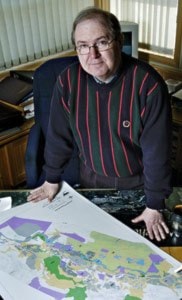Policy, process and planning are becoming dirty words to some Yukoners frustrated by the “outdated,” lengthy process of acquiring, developing and protecting the territory’s land.
“I put in an application under one set of rules and by the time it’s filtered through the system the rules have changed,” a frustrated would-be developer told the group of 30, and four panelists, gathered at the United Church for an New Democratic Party-sponsored land forum Thursday evening.
“How long can they plan? I’m going to be in MacAulay Lodge soon,” he added with a laugh.
The meeting, which was coloured by incomprehensible angry outbursts, focused on community frustration with the “hot-button” issue of land acquisition in the territory.
Frustration stems from the lack of First Nations consultations to the city failing, time and again, to open new residential lots for development, and everything in between.
And the nearly two-hour meeting only scratched the surface, sparking a wealth of questions with few concrete solutions.
Most of the blame was clearly directed towards the Yukon government’s policies and practices.
Bureaucrats are just as bogged down with policy as the developers and residents, so it’s up to the politicians to affect change, said Mark Stephens, chair of the Mount Lorne council.
“It’s up to the politicians to start looking at new policy regimes, new legislative and regulatory regimes post-devolution and post-land claims so that we can work with First Nations and local communities better.”
The forum comes on the heels of a hastily-called news conference, Thursday afternoon, where Resources minister Archie Lang announced plans to develop the final phase of Copper Ridge freeing 106 lots; a new 20-lot country residential subdivision at the corner of the Mayo/Hot Springs Road; 59 lots in Grizzly Valley and additional lots in the new Whitehorse Copper country residential subdivision and Mount Lorne.
This is a first step in affecting change on how land is protected and distributed in the territory, said NDP leader Todd Hardy, who called the meeting.
“This is a government that has not been doing the hard work,” said Hardy. “What we’re witnessing is a massive amount of conflict that we haven’t witnessed in a long time covering issues from the municipal to college endowment to subdivision planning to First Nations to court cases.
“We’ll be gathering information on how to address the growing conflicts,” said Hardy, who plans to take the discussion into Yukon communities later this spring.
And the NDP may be on to something with its open-dialogue approach to land-use planning.
Most Whitehorse stakeholders want frequent, meaningful consultations.
“We have to figure out what co-management it,” said John Pattimore, Ta’an Kwach’an Council lands management co-ordinator.
“What’s not being done that really pisses the First Nations off, is proper consultation early, regularly and often.”
The call for meaningful consultation was echoed at Wednesday evening’s education session on land use, Balancing Growth and our Greenspace, co-sponsored by the city and the Canadian Mortgage and Housing Corporation.
About 80 politicians, planners and citizens crammed into a conference room at the Westmark Whitehorse to piece together solutions to the city’s land woes.
“The big turnout is a testament to how much Whitehorse cares about what happens to its land,” said meeting facilitator Vinay Bhardwaj, CMHC department manager.
The workshop turned into a true community meeting with an open dialogue between the city and public — it even garnered a few hearty laughs.
It lasted nearly three hours with many people hanging around to have one-on-one conversations with city planners.
People need to feel they’re being listened to, said Bhardwaj.
The meeting is a step towards balancing the land needs of the growing population with environmental and fiscal restraints, said Whitehorse mayor Ernie Bourassa.
The city is facing a “land crunch,” said Bourassa, noting there are few lots available for development in the city over the next few years.
“We are under some severe constraints in the areas we can actually go in and develop,” said Bourassa. “Either because the areas are zoned greenbelt or environmental protection or because they’re un-developable, or because the costs associated with going there are so huge at the moment that we’d be looking at pricing them in the range of $150,000 to $200,000.”
After failed residential subdivision development plans in Riverdale, Takhini North and Porter Creek over the past year, the city is trying to address the bigger problems.
“We need to collaborate, if we don’t land development could come to a halt in the city,” said Bourassa.
“The future is looking good, the problem is that’s in the longer term. It’s the two-year out future that we’re concerned with,” said Bourassa.
“We have to do something in the meantime because there aren’t going to be a lot of lots available next year. Probably we’ll be out of lots.”
Porter Creek, in the McIntyre Creek area, and Takhini North are the next two areas targeted for development, added Bourassa.
